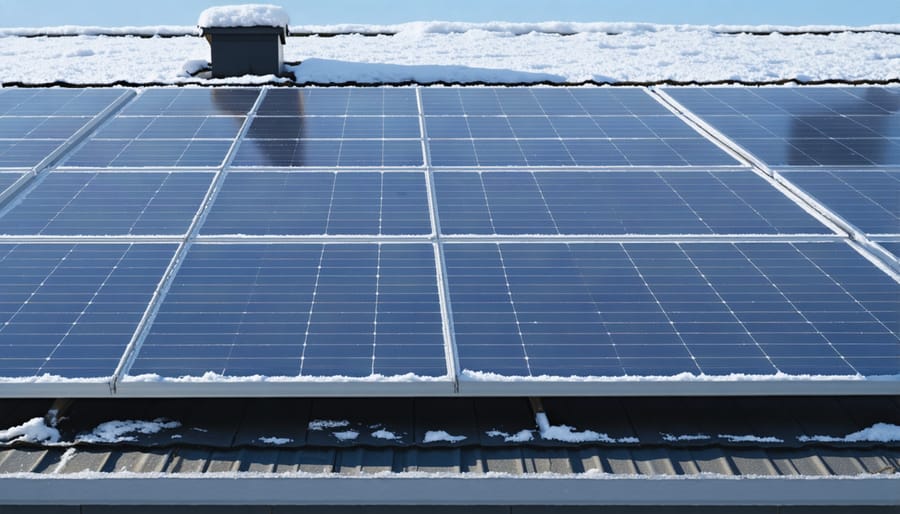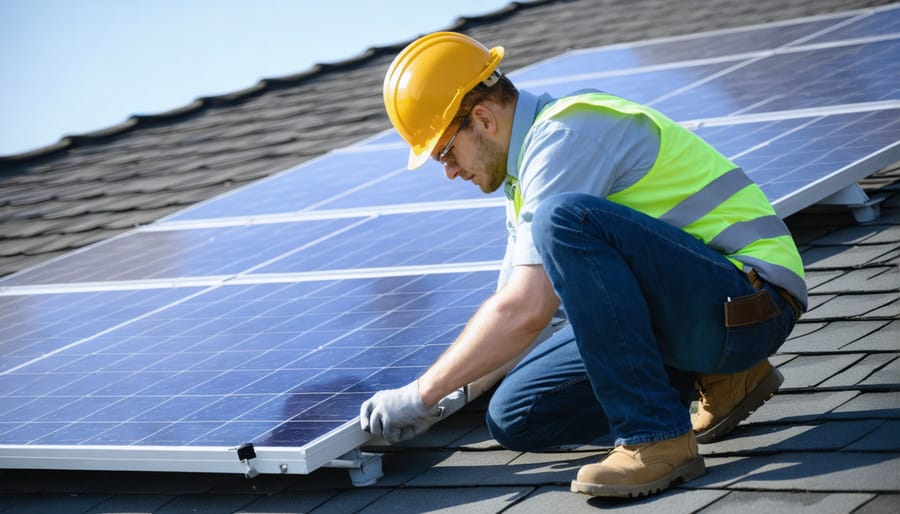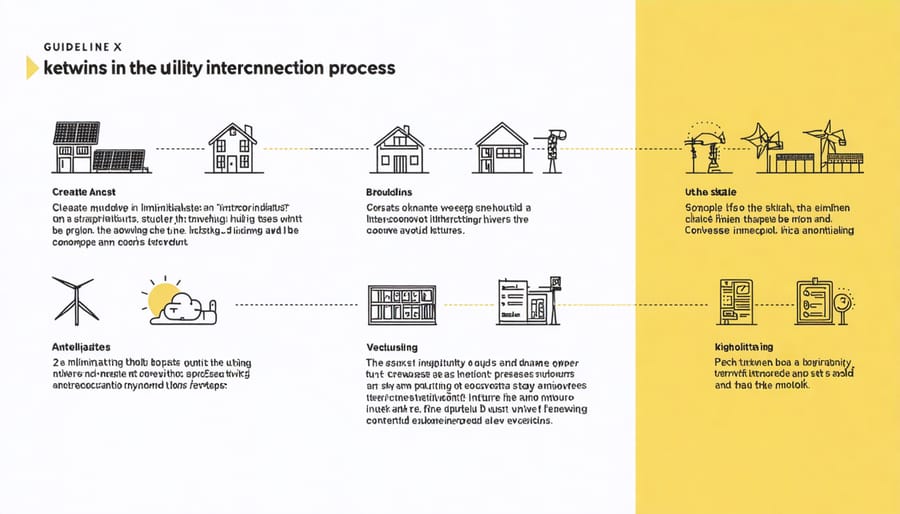Solar Project Risk Prevention: Proven Strategies That Keep Your Investment Safe
Successfully managing project risks requires a strategic blend of foresight, planning, and adaptable solutions. In Illinois’s dynamic business environment, project managers face unique challenges that demand robust risk mitigation strategies – from extreme weather impacts on construction timelines to regulatory compliance hurdles specific to our region.
Effective risk management isn’t just about identifying potential problems; it’s about developing practical, actionable solutions that protect project outcomes and stakeholder investments. Recent industry data shows that projects with comprehensive risk mitigation plans are 70% more likely to meet their objectives and stay within budget constraints.
Understanding and addressing risks early in the project lifecycle creates a foundation for success. Whether you’re managing a residential solar installation or overseeing a large-scale commercial development, the key lies in anticipating challenges before they emerge and having tested strategies ready for implementation. From supply chain disruptions to workforce availability, each potential risk requires a tailored approach that considers both immediate impact and long-term consequences.
This guide explores proven risk mitigation strategies specifically designed for Illinois projects, combining industry best practices with local expertise to help you navigate common challenges while maintaining project momentum and stakeholder confidence.
Weather-Related Risks in Illinois Solar Projects
Snow Load and Winter Challenges
Winter weather in Illinois presents unique challenges for solar installations, with snow loads being a primary concern. A typical solar array must be engineered to support both the weight of accumulated snow and withstand the freeze-thaw cycles common in our region. Professional installers calculate these loads during the design phase, typically accounting for up to 30 pounds per square foot of snow weight.
To mitigate winter-related risks, we implement several proven strategies. First, panels are installed at an optimal angle (typically 30-45 degrees in Illinois) to encourage snow sliding off naturally. Special mounting systems with enhanced structural support are used to handle additional winter weight loads. We also recommend installing snow guards in certain situations to prevent dangerous snow slides near entrances or walkways.
Regular winter maintenance becomes crucial for system performance. While solar panels often self-clear due to their smooth surface and angle, some situations may require professional cleaning to prevent extended power loss. The good news is that cold temperatures actually improve solar panel efficiency, and the white snow can reflect additional light onto the panels, potentially increasing production on clear winter days.
System monitoring helps identify any winter-related performance issues promptly, allowing for quick intervention when necessary.

Storm Protection Measures
In Illinois’s variable climate, protecting solar installations from severe weather is crucial for long-term system reliability. Modern solar panels are engineered to withstand most weather conditions, but additional measures can enhance their durability and performance during extreme events.
Strong mounting systems form the foundation of storm protection. Professional installers use reinforced racking systems and additional mounting points to secure panels against high winds common in the Midwest. Wind deflectors can be installed along the edges of arrays to reduce uplift forces during storms.
Lightning protection systems, including properly grounded equipment and surge protectors, safeguard the electrical components from power surges and direct strikes. Automated tracking systems can adjust panel angles during severe weather to minimize wind resistance and protect against hail damage.
Regular maintenance checks help identify potential vulnerabilities before storms hit. This includes inspecting mounting hardware, ensuring drainage systems are clear, and verifying that all components are properly secured. Some installations benefit from protective covers or screens that can be deployed during hail storms.
Insurance coverage specifically designed for solar installations provides an additional layer of protection, covering potential storm-related damages and helping ensure quick repairs when needed. Working with local installers familiar with Illinois weather patterns ensures your system includes appropriate protective measures for our specific climate challenges.
Technical Installation Risks
Roof Integrity Assessment
A thorough roof assessment is a critical first step in any solar installation project. Your roof must be able to support both the weight of the solar panels and withstand Illinois’s diverse weather conditions. The evaluation process begins with a detailed structural analysis, checking for any existing damage, weak spots, or areas that need repair.
Our certified inspectors examine key elements including roof age, material condition, and load-bearing capacity. For typical residential installations in Illinois, roofs should be able to support an additional 2.5-4 pounds per square foot. The assessment also considers local building codes and specific requirements for solar installations in your municipality.
Special attention is paid to the roof’s orientation, slope, and shading patterns, as these factors directly impact solar panel efficiency. We evaluate the structural integrity of rafters and trusses, ensuring they can handle both the dead load (constant weight) and live loads (snow, wind, and maintenance activities).
Common risk factors we look for include water damage, deteriorating shingles, and inadequate support structures. If any issues are identified, we recommend necessary repairs or reinforcements before proceeding with installation. For older roofs approaching the end of their lifespan, we might suggest roof replacement prior to solar panel installation to avoid costly reinstallation later.
Our assessment also includes a detailed documentation process, providing you with a comprehensive report of findings and recommendations.

Equipment Quality Control
Quality control of solar equipment plays a crucial role in ensuring project success and longevity. Regular inspections and testing of components before and during installation help maintain optimal panel performance and system reliability throughout its operational life.
Key quality control measures include thorough visual inspections of panels for manufacturing defects, micro-cracks, or shipping damage. Each panel should undergo electrical testing to verify output ratings match specifications. Inverters, mounting hardware, and wiring components must meet UL certification standards and local Illinois building codes.
Documentation of component serial numbers, test results, and inspection findings creates a reliable audit trail and supports warranty claims if needed. Working with certified installers who follow manufacturer guidelines ensures proper handling and installation techniques are used.
Implementing a structured maintenance schedule helps identify potential issues before they impact system performance. This includes regular cleaning, connection checks, and performance monitoring. For Illinois installations, special attention should be given to snow load ratings and wind resistance capabilities of mounting systems.
By maintaining strict equipment quality control standards, property owners can significantly reduce the risk of component failure and maximize their solar investment’s return. Regular communication with suppliers and installers about quality expectations helps ensure all parties maintain high standards throughout the project lifecycle.
Financial Risk Management
Insurance Coverage Requirements
Securing appropriate insurance coverage is a crucial step in protecting your solar investment. While exploring solar incentives in Illinois, it’s equally important to understand insurance requirements for your installation.
Property owners should ensure their existing homeowner’s or commercial property insurance policies explicitly cover solar installations. Many standard policies may need endorsements or riders specifically for solar equipment. Key coverage areas should include:
– Property damage from severe weather events common in Illinois
– Equipment breakdown and mechanical failure
– Theft or vandalism of solar components
– Liability coverage for potential injuries related to installation or maintenance
– Business interruption coverage for commercial installations
– Performance guarantee insurance
We recommend working with insurance providers experienced in renewable energy projects. They can help determine appropriate coverage levels based on system size, location, and specific risk factors. Typical coverage amounts range from $500,000 to $2 million for residential installations and may be higher for commercial projects.
Contractors should maintain their own comprehensive insurance, including:
– General liability insurance
– Workers’ compensation
– Professional liability coverage
– Installation floater insurance
Request certificates of insurance from all contractors and verify coverage limits meet local requirements and industry standards before beginning your project.
Performance Guarantees
Performance guarantees and production warranties are essential safeguards for your solar investment in Illinois. Most quality solar installations come with two primary types of warranties: equipment warranties and performance guarantees. Equipment warranties typically cover physical components like panels and inverters for 25-30 years, protecting against manufacturing defects and premature wear.
Performance guarantees, on the other hand, ensure your system produces the promised amount of electricity over time. These guarantees usually specify that your system will maintain at least 80-85% of its original production capacity after 25 years. It’s crucial to understand that actual production can vary based on weather conditions, seasonal changes, and maintenance practices unique to Illinois’s climate.
To secure the best warranties, work with certified installers who offer comprehensive documentation of all guarantees. Keep detailed records of your system’s performance and schedule regular maintenance checks. Many warranties require proper maintenance to remain valid, so understanding these requirements is essential.
Be sure to review warranty terms carefully, noting coverage periods, claim procedures, and any conditions that might void the warranty. Some manufacturers offer additional protection through extended warranties or production guarantees, which can provide extra peace of mind for your solar investment.
Remember that warranty terms can significantly impact your system’s long-term value and return on investment, making them a crucial factor in your solar planning process.
Regulatory Compliance Strategies
Local Permit Requirements
Before initiating any solar installation project in Illinois, it’s crucial to understand and comply with local regulatory requirements. Each municipality may have specific zoning laws, building codes, and permit processes that directly impact your solar project’s timeline and costs.
Common permit requirements include structural engineering assessments, electrical plans, and site surveys. Many Illinois communities require additional documentation such as homeowners’ association approval or historical district compliance. To mitigate permit-related risks, consider these essential steps:
1. Research local codes early in the planning phase
2. Engage with municipal authorities to understand specific requirements
3. Budget for permit fees and potential modifications
4. Allow extra time for permit processing and inspections
5. Maintain detailed documentation of all submissions and approvals
Working with experienced local solar installers can significantly reduce permit-related complications, as they’re familiar with specific requirements in different Illinois jurisdictions. They can help navigate the approval process, ensure compliance with local ordinances, and anticipate potential challenges before they arise.
Remember that permit requirements can change, so it’s important to verify current regulations even if you’ve completed similar projects in the past.
Utility Interconnection Process
The utility interconnection process in Illinois requires careful planning and coordination with your local utility company. This critical step ensures your solar installation can safely connect to the power grid while meeting all regulatory requirements. Typically, the process begins with submitting an interconnection application to your utility provider, which includes technical specifications and system design details.
To minimize delays and complications, gather all required documentation early and ensure your system design complies with Illinois utility standards. Common challenges include incomplete applications, technical review delays, and scheduling conflicts for final inspections. Working with an experienced solar installer familiar with local utility requirements can significantly streamline this process.
Consider these key mitigation strategies:
– Submit applications early in the project timeline
– Double-check all technical specifications before submission
– Maintain regular communication with utility representatives
– Schedule inspections well in advance
– Keep detailed records of all correspondence and approvals
Most Illinois utilities aim to complete the interconnection process within 30-45 days, though complex projects may take longer. Building extra time into your project schedule for potential delays and maintaining flexibility with installation dates can help manage expectations and reduce stress during this phase.

Project Timeline Management
Effective solar project management requires careful timeline planning to ensure installations stay on track. In Illinois, where weather conditions can be unpredictable, maintaining project schedules demands proactive strategies and built-in flexibility.
Start by creating a detailed project timeline with clear milestones and dependencies. Include buffer periods for weather-related delays, particularly during winter months when snow and ice can impact installation work. Establish regular check-ins with all stakeholders, including contractors, suppliers, and utility companies, to monitor progress and address potential delays early.
Document procurement lead times, especially for critical components like panels and inverters. Current supply chain challenges make it essential to order materials well in advance. Consider local permitting timelines, which vary by municipality in Illinois, and factor these into your schedule.
Implement a digital tracking system to monitor milestone completion and identify potential bottlenecks. This allows for quick adjustments when needed and helps maintain transparency with clients. Set up automated alerts for upcoming deadlines and permit renewals to prevent administrative delays.
Keep detailed records of any schedule changes and their causes. This information proves valuable for future project planning and helps refine timeline estimates. Remember to communicate timeline updates promptly to all stakeholders, maintaining clear channels for questions and concerns throughout the project duration.
Successful solar project implementation in Illinois requires a proactive approach to risk management. By conducting thorough site assessments, securing necessary permits, and working with qualified local installers, property owners can significantly reduce potential complications. Regular maintenance schedules, comprehensive insurance coverage, and clear communication channels with all stakeholders form the foundation of effective risk mitigation. Moving forward, it’s essential to document lessons learned from each project phase and maintain updated contingency plans. Remember that while risks are inherent in any solar installation, proper planning and partnership with experienced professionals can ensure your renewable energy investment delivers long-term value and reliable performance. Stay informed about local regulations, industry best practices, and emerging technologies to adapt your risk management strategy as needed.


